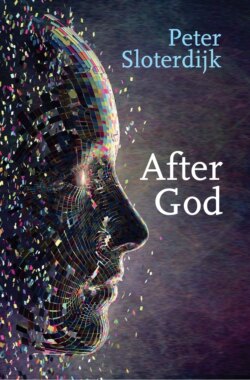After God

Реклама. ООО «ЛитРес», ИНН: 7719571260.
Оглавление
Peter Sloterdijk. After God
Contents
Guide
Pages
After God
Copyright page
Translator’s Note
1 TWILIGHT OF THE GODS “Every world of gods is followed by a twilight of the gods”*
I
II
III
Note
Notes
2 IS THE WORLD AFFIRMABLE? On the Transformation of the Basic Mood in the Religiosity of Modernity, with Special Reference to Martin Luther. 2.1 The eccentric accentuation
2.2 And they saw that it was not good
2.3 The derivation of the Reformation from the spirit of tempered despair
2.4 Protestant entropy
Notes
3 THE TRUE HERESY: GNOSTICISM On the World Religion of Worldlessness. 3.1 Where Nag Hammadi is located
3.2 How the real world finally became an error
3.3 A short history of authentic time
3.4 Gnosticism as negative psychology
3.5 Demiurgical humanism: On the Gnosticism of modern art
References for Chapter 3
Notes
4 CLOSER TO ME THAN I AM MYSELF A Theological Preparation for the Theory of the Shared Inside*
Note
Notes
5 GOD’S BASTARD The Caesura of Jesus*
Note
Notes
6 IMPROVING THE HUMAN BEING Philosophical Notes on the Problem of Anthropological Difference
Notes
7 EPOCHS OF ENSOULMENT Suggestions for a Philosophy of the History of Neurosis
Notes
8 LATENCY On Concealment. 8.1 Emergence of the krupta
8.2 Maximally invasive operation
8.3 Boxing in as latency production
8.4 Wadding up and unfolding
8.5 Intuitive integral calculus
Notes
9 THE MYSTICAL IMPERATIVE Remarks on the Changing Shape of Religion in the Modern Age. 9.1 Martin Buber’s Ecstatic Confessions as an epochal symptom
9.2 Religion in the age of the experiment
9.3 World arena and unmarked space
Notes
10 ABSOLUTE AND CATEGORICAL IMPERATIVE
Note
11 NEWS ABOUT THE WILL TO BELIEVE A Note on Desecularization
Notes
12 CHANCES IN THE MONSTROUS A Note on the Metamorphosis of the Religious Domain in the Modern World, with Reference to a Few Motifs in William James
Notes
Editorial Note*
Note
POLITY END USER LICENSE AGREEMENT
Отрывок из книги
Peter Sloterdijk
Translated by Ian Alexander Moore
.....
It is no accident that the pious have always suspected that large cities were hotbeds of atheism. And they were right to do so, for city dwellers have always been surrounded by proofs of the mind and of the power of purely human environment formations. Since the days of the Tanakh (in Christian language, the Old Testament) the name “Babylon” has stood for the funfair of artificialities. This inevitably turns people’s attention away from the one thing that is necessary. The artificial environment of the city directs its inhabitants more toward themselves and toward the architectonic ambitions of their predecessors than toward the work of the gods or of God. The fact that metropolises such as Jerusalem, Rome, and Benares survived as holy cities proves only that certain priestly elites were able to mystify their cities as theaters of constructed proofs of God. In Chicago, Singapore, and Berlin, as well as in other urban agglomerations around the earth, such a maneuver would have failed beforehand.
If we wish to use terms from philosophy and cultural studies to interpret what is going on with the dynamic of the twilight of the gods, it will be necessary to revise the classic metaphysical image of giving back one’s soul. We need not infringe on the noble idea of the soul’s returning home to a transcendent source. However, it will be essential for us to rethink the figure of the testament or of the “legacy,” from the ground up. In the civilization of modernity, which is animated by creativism and where artificiality is raised to ever higher powers, we can no longer ignore the fact that human intelligence flows out into “works” or artifacts. And this is so even if, today as always, their creators succumb to mortality. (The secondary outflowing of mass culture into trash is another theme.)
.....